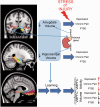Chronic Pain and Chronic Stress: Two Sides of the Same Coin?
- PMID: 28795169
- PMCID: PMC5546756
- DOI: 10.1177/2470547017704763
Chronic Pain and Chronic Stress: Two Sides of the Same Coin?
Abstract
Pain and stress share significant conceptual and physiological overlaps. Both phenomena challenge the body's homeostasis and necessitate decision-making to help animals adapt to their environment. In addition, chronic stress and chronic pain share a common behavioral model of failure to extinguish negative memories. Yet, they also have discrepancies such that the final brain endophenotype of posttraumatic stress disorder, depression, and chronic pain appears to be different among the three conditions, and the role of the hypothalamic-pituitary-adrenal axis remains unclear in the physiology of pain. Persistence of either stress or pain is maladaptive and could lead to compromised well-being. In this brief review, we highlight the commonalities and differences between chronic stress and chronic pain, while focusing particularly on the central role of the limbic brain. We assess the current attempts in the field to conceptualize and understand chronic pain, within the context of knowledge gained from the stress literature. The limbic brain-including hippocampus, amygdala, and ventromedial pre-frontal cortex-plays a critical role in learning. These brain areas integrate incoming nociceptive or stress signals with internal state, and generate learning signals necessary for decision-making. Therefore, the physiological and structural remodeling of this learning circuitry is observed in conditions such as chronic pain, depression, and posttraumatic stress disorder, and is also linked to the risk of onset of these conditions.
Keywords: amygdala; depression; hippocampus; limbic circuitry; pain; posttraumatic stress disorder; stress.
Conflict of interest statement
Declaration of Conflicting Interests The author(s) declared no potential conflicts of interest with respect to the research, authorship, and/or publication of this article.
Figures

References
-
- Murrough J, W. Abdallah, C. G., Mathew, S. Targeting glutamate signaling in depression: progress and prospects. Nat Rev Drug Discov. In press. - PubMed
-
- Breivik H, Collett B, Ventafridda V, Cohen R, Gallacher D. Survey of chronic pain in Europe: prevalence, impact on daily life, and treatment. Eur J Pain 2006; 10: 287–333. - PubMed
-
- Bair MJ, Robinson RL, Katon W, Kroenke K. Depression and pain comorbidity: a literature review. Arch Intern Med 2003; 163: 2433–2445. - PubMed
-
- Knaster P, Karlsson H, Estlander AM, Kalso E. Psychiatric disorders as assessed with SCID in chronic pain patients: the anxiety disorders precede the onset of pain. Gen Hosp Psychiatry 2012; 34: 46–52. - PubMed
Grants and funding
LinkOut - more resources
Full Text Sources
Other Literature Sources
Medical

